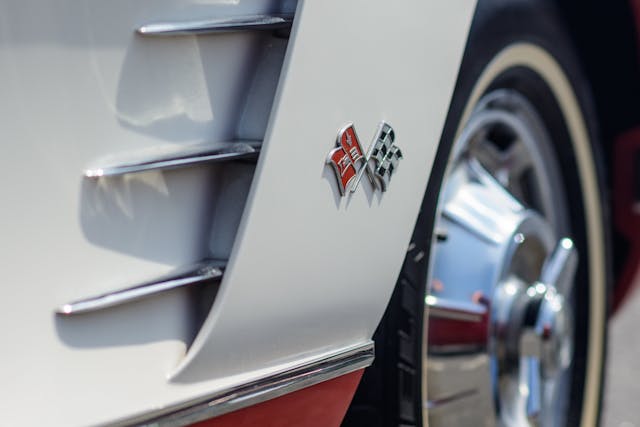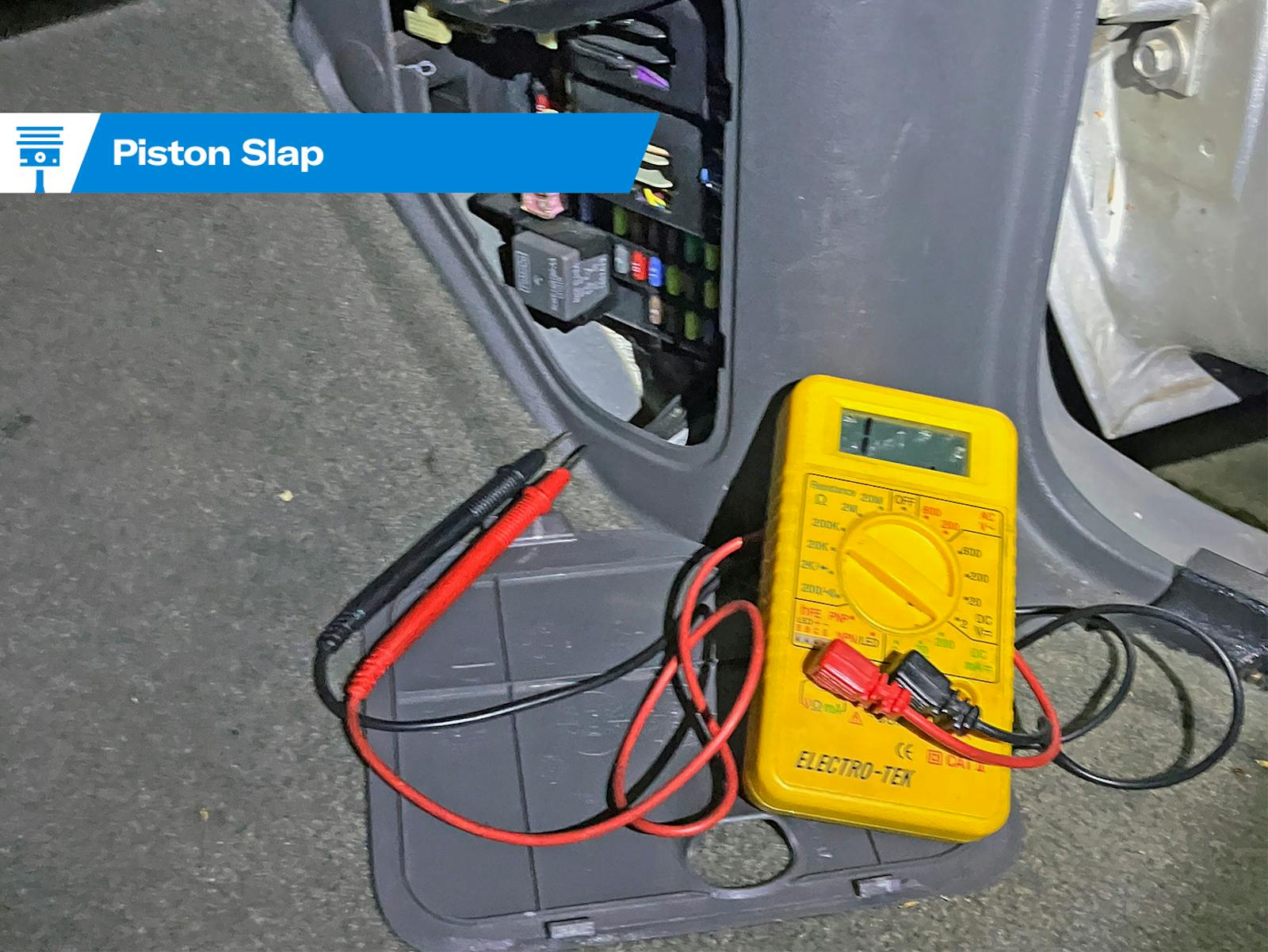How I saved my neighbor’s vintage Corvette from death by fire
It was a regular Saturday. I was tinkering with a sticky carburetor float on my Lotus Esprit when a neighbor pulled up in his mint 1959 Chevrolet Corvette.
We got to talking, bonding over the pitfalls of fiberglass bodywork, and other assorted highs and lows of the old car ownership. We exchanged numbers and agreed to head out on an early Sunday morning coffee run in our classics.
The weather was hot. When he went to restart the Vette it just wouldn’t play ball. We wondered if it was flooded or the high temperatures were causing a fuel evaporation problem. Talk, however, is cheap and it was clear that he couldn’t leave his car in the road, so my wife and I began to roll it gently to the curb.
As we pushed, ominous black smoke started spewing from under the hood. My neighbor hopped out and popped the engine cover. Flames leapt out from the edges and I shouted for him to close the hood, while I sprinted back to the Esprit to grab an extinguisher.
Specifically, I grabbed a recently-purchased Fire Safety Stick, which had been recommended by a fellow Esprit enthusiast. Lighter (just 7.6 ounces) and more compact than a regular powder extinguisher, the stick is not unlike a flare, but with the opposite effect.

I rapidly read the instructions, removed the safety cap and struck the top of the stick with the igniter. Inside, the triggered chain reaction caused the stick to emit a powerful spray of nitrogen and potassium free radicals, which starve any fire of oxygen.
Mr. Corvette (he prefers to keep his name out of it) opened the hood again and I pointed the stick at the air filter where the flames were spewing out. He then grabbed it off me to run around the other side of the car and finish the job. Within a minute the fire was out, and a near-$200,000 vehicle was saved.
Amazingly, there was only a small amount of blistering on the hood from the heat. Even more remarkably, when the owner had to move the car a day later it started on the button.

The people behind the Fire Safety Stick (sold as Element in the U.S.A.) told me that’s down to the fact that the product leaves almost no residue behind.
Andrew Robinson from Argento Global Solutions, the company that imports the stick in the U.K., explains that’s why many motorsport teams have now started carrying Fire Safety Sticks in addition to traditional plumbed-in extinguisher systems.
The technology, he explained, was actually invented in Soviet Russia during the space race, but it wasn’t until 20 years ago or so that an Italian company bought the rights and began manufacturing and selling the devices.
Having seen the stick in action, I immediately ordered another and highly recommend you do the same. Meanwhile, my neighbor, who has a collection of 11 classics, has probably become their biggest customer.
***
Check out the Hagerty Media homepage so you don’t miss a single story, or better yet, bookmark it. To get our best stories delivered right to your inbox, subscribe to our newsletters.



Interesting product. And quick thinking on your part, Nik! I once had to pull an aluminum engine completely out of a car just to achieve cleanup after a “regular” powder-filled extinguisher had been used on it. That stuff is extremely caustic.
Thanks! I really was amazed at how well it worked and how little mess it left behind .
I love the concept. I’d like to see how it stacks up against a Halon extinguisher. Where can I get one of those?
Our friends at the jungle website sell it. Or, you can head to https://elementfire.com/.
Bought 2 one for our 54 Chevy truck and the other for our 2016 Silverado saw them being used a no brainier cost of vehicle to cost of the element fire extinguisher
They (Element) are marketed and sold thru many Porsche related sites. About $75 and sometimes go on sale (~ 15% off).
I thought Halon was banned ?
You can gets these at elementfire.com. at a very low cost and work well, and you might be taking about Halotron, also used in aircraft industry now. Halon isn’t available like it was in the past. Element works on time. The 50 gets you 50 seconds of use. The 100 gets you double. Typical 2.5 lb. extinguishers run 15 seconds at best. I’ve used mine at an accident so I know first hand. Any 1 lb. bottle isn’t worth the price for what the do. Bottles can throw farther but the sticks can be used in a quick approach and ultimately do the same as a bottle for much longer. They are proven but not UL rated due to testing standards for bottles that don’t apply to the stick. Don’t let this stop you from getting one. After use you just throw it away. So much better for cars and electronic equipment than the cheaper powder which will cause caustic after fire damage. Element is non caustic. If you still want a bottle, get the H3R Halotron 2.5 lb. or larger, also non caustic. Peace of mind either way.
Only professionals should fight fires. Get to safety and call 911.
I would agree if we were talking about a house fire, but a vehicle engine compartment fire is a different issue. In over 40 years of fire / law enforcement experience I’ve yet to see a vehicle “explode” during a fire.
Strongly disagree, unless one gives not a care for their car. Depending upon where one is, and how much of the car is involved in the fire, try the extinguisher first, IF one feels comfortable doing so; if you have a passenger, have them call 911 at the same time.
I saved my 1977 Dodge from a sudden dash fire, with relatively minor damage, using my fire extinguisher. As fast as the fire was spreading, I estimate that another 30 seconds would have seen the whole dash involved, and a minute would have seen the whole interior involved, with the rest of the car no doubt to follow. No way a fire truck could have arrived in time to save the car. I was careful, and sprayed thru the doorway of the car – not getting in! Another time, I stopped a just-started oil fire on an old Nova’s engine, again with quick extinguisher usage.
Of course, if there is a fire anywhere near the gas tank, or if the engine (or anywhere else on the car) is heavily involved, better make the call, and stay safely clear. Same thing, if one is not comfortable using the extinguisher.
Most ridiculous thing I’ve ever heard. Fire extinguishers are made for consumer use for a reason. That’s like watching your beloved spouse hit the floor with a heart attack, not performing CPR and saying “only professionals should perform CPR.”
Jeez.
Agreed, good analogy.
As a retired firefighter I can tell you a fire doubles in size every 30 sec if fuel and air are present. Very easy to put out with an extinguisher early on. Most fire depts. give free training in the use of extinguishers. Take advantage of it.
I have to disagree my friend. My 1969 428 4 speed Mach 1 would have been destroyed if I did not quickly react and grab a fire extinguisher from the maintenance shop at the steel mill I was working at.
I have an Element in my 2000 C5, my 2007 S600, and one in my 2017 Mustang GT. The author is absolutely right. This little gem will save your car, your wallet, and your dignity if you have a fire – fuel or electrical.
Bought one of these last month. Glad to see it’s money well spent!
sounds like an ad dressed up to be an article,
So Hagerty has become an ad spam site?
So…they should not report on firsthand experiences with a good product?
You’re surprised? “Product placement” aside. I think they (Element) are worth a look. I got interested after buying my ’89 944 and then seeing some videos of fires caused by fuel Inj. hose failures in the engine compartment.
You don’t want your insurance company telling you about a good fire suppression product?
Hagerty is an INSURANCE Company. They would rather not have to pay for a destroyed car.
Good information for real car people
I bought one of these awhile ago after looking at all of the videos (there are more now with good saves). After having a car fire once and dealing with the traditional extinguisher residue, this is a no-brainer. I’ve forwarded this product on to other car guys since.
I purchased an Element a year and a half ago for my dune buggy show car. My previous buggy caught fire on the Mayport Ferry in Jacksonville, Florida. Luckily the crew put it out quickly but the mess was terrible from the extinguisher. I’m prepared now. Small and compact it’s mounted within arms reach and yes I’ll use it to save my baby!
Did he buy you the replacement…LOL
I’ve been considering this purchase and realize it’s time to get one. However, I will also keep my dry chemical extinguisher just in case I drop the striker cap down a storm drain during my panic!!!
We will also need to remember to point the stick in the proper direction during those panicky first moments. I think I might buy a couple and practice on my fire pit.
Thanks for the information. The fire was put out in the time it would take to call 911 and report the location. Always good to see the sour balls show up too.
Trolls gonna troll, haters gonna hate, doubters gonna doubt – and naysayers gonna nay.
I keep one of those by my stove at home and in the door pocket of my ‘81 911
This does sound like an ad to sell stuff, Granted it sounds like a good product but the article states that “I pointed the stick at the air filter where the flames were spewing out.” I was always taught that it flames are coming out of the carb that you turn the engine over and suck the fire back into the engine to put it our.
That only works at the initial event of a backfire. Once a fire gets going, it’s too late for that to do any good.
Besides, by the time you get the motor unbolted from the motor mounts and exhaust manifolds its probably too late!
I knew someone who tried that. The brass in the carb melted.